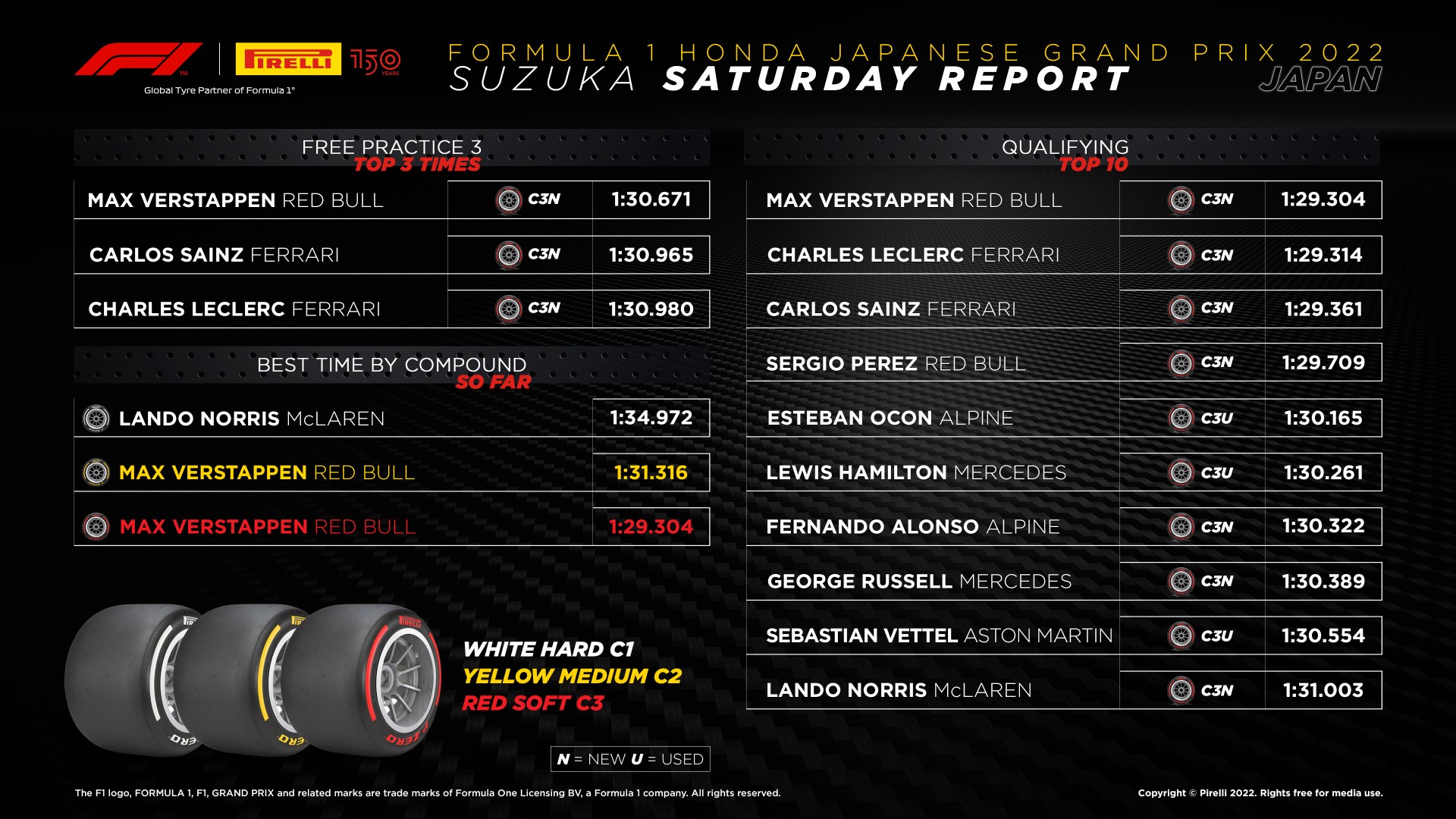2022 Japanese Grand Prix - Saturday
THE ROAD TO POLE
- Red Bull driver Max Verstappen was fastest In qualifying, with the top three drivers covered by just six-hundredths of a second, having used the P Zero Red soft tyre from start to finish. The same tactic was used by all the teams, with the exception of Mercedes, which ran the P Zero Yellow medium in Q1.
- Conditions remained dry all day, with qualifying getting underway at 3pm in 21 degrees centigrade ambient and 23 degrees of track temperature.
- Verstappen also went fastest in the hour-long FP3 session this morning, setting fastest time on the soft tyre. With FP3 being the first time that the teams had run the slick compounds, they concentrated on maximising their learning and collecting as much data as possible in a variety of configurations, including long runs.
- With yesterday having been declared wet, the teams were entitled to a carry-over set of slick tyres for FP3, before handing them back as per the regulations. This gave the opportunity for extra running.
- We learned today that the degradation on the soft and medium tyres seems higher than expected, while the performance gap between them is less than the estimation. We saw no graining.
- The Pirelli Pole Position Award was given to Verstappen by Robert Reid, the current FIA Deputy President for Sport and 2001 World Rally Champion co-driver. Reid, who won his title alongside the late Richard Burns on Pirelli tyres, is closely linked to Japanese motorsport, having competed for manufacturers like Mitsubishi and notably Subaru – with whom he claimed his world championship 21 years ago. In his former role, Reid has also been involved in developing young rally drivers through the Pirelli Star Driver scheme – organised in collaboration with the FIA – and he is additionally a previous winner of the Pirelli International Rally in his native United Kingdom: a round of the British Rally Championship based near Pirelli’s facility in Carlisle.
STRATEGY NOTEBOOK
With just one hour of free practice this morning, the teams are lacking dry data for the 53-lap Japanese Grand Prix. The fastest strategy on paper is a two-stopper using the soft and medium tyres: probably with the medium used once during the middle stint. Soft followed by two medium stints is another viable two-stopper, for those with two mediums left.
A one-stopper could be possible as well, depending on degradation rates. This could be soft to P Zero White hard, or medium to hard – which is slightly slower on paper but requires less management. What’s clear is that all three compounds have a valid role to play tomorrow and a wide variety of strategies are theoretically possible.
The weather and track conditions on Sunday will ultimately decide the way to go. Track temperatures are expected to be a bit cooler than today and there’s a still a chance of rain.
This might favour the softer compounds – while the wet running yesterday could turn out to be extremely useful as well.

Suzuka is a perfect example of Pirelli’s ‘race to road’ philosophy, of using competition to improve the road car product. The epic circuit was originally conceived as a test track: similar to Pirelli’s own test tracks in Italy and further afield that the Italian firm uses to refine its ultra high performance tyres over a wide range of conditions and surfaces. Suzuka was commissioned by Soichiro Honda in the late 1950s as the first proper circuit in Japan, completed in September 1962. It’s well-known as a demanding yet balanced track that challenges every aspect of a vehicle’s dynamics. This makes it an ideal venue for testing.


















